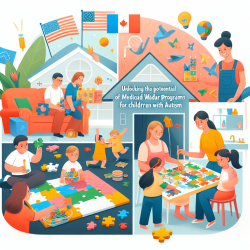Introduction
Toilet training can be a challenging process, especially for children with disabilities. However, with the right strategies and evidence-based practices, practitioners can overcome barriers and help these children achieve continence. The research article "Resolving Barriers to Continence for Children with Disabilities: Steps Toward Evidence-Based Practice" provides valuable insights and solutions to common obstacles faced during toilet training.
Understanding the Barriers
Despite the effectiveness of Behavior-Analytic Toilet Training (BATT) methods, children with disabilities often face barriers such as problem behavior, excessive urine retention, recurrent accidents, and issues with self-initiations. These barriers can interfere with the training process, leading to long-term incontinence and associated problems.
Strategies for Overcoming Barriers
The research article highlights several strategies that practitioners can use to address these barriers:
- Modify or Eliminate Aversive Components: Simplifying or removing overcorrection and reducing the duration of toilet sits can help reduce problem behavior.
- Functional Assessment and Differential Reinforcement: Conducting functional assessments can help identify the reinforcers for problem behavior and inform the design of differential reinforcement strategies.
- Transfer Stimulus Control: Shaping and fading techniques can help transfer stimulus control over urination from diapers to the toilet.
- Negative Reinforcement Contingencies: Allowing the end of a toileting session contingent on urination can encourage children to void in the toilet.
- Enhance the Salience of Accidents: Using urine alarms or dry pants checks can increase awareness of accidents and help establish continent urination as a discriminated operant.
- Revise Toileting Schedules: Increasing the frequency of scheduled toilet sits can provide more opportunities for reinforcement of continent voids.
- Monitor Fluid Intake: Adjusting fluid intake can help manage accidents related to excessive hydration.
- Teach Self-Initiations: Introducing supplemental cues and fading prompts can encourage independent toilet requests.
Implementing Evidence-Based Practice
Practitioners should adopt an evidence-based practice framework when designing and delivering toilet training services. This involves using professional judgment, the best available evidence, and considering client values and contextual variables. By systematically modifying intervention methods, practitioners can help clients achieve their continence goals.
Conclusion
Toilet training for children with disabilities can be a complex process, but with the right strategies and evidence-based practices, practitioners can overcome barriers and help these children achieve continence. By staying informed and adapting their approaches, practitioners can make a significant difference in the lives of these children and their families.
To read the original research paper, please follow this link: Resolving Barriers to Continence for Children with Disabilities: Steps Toward Evidence-Based Practice.










